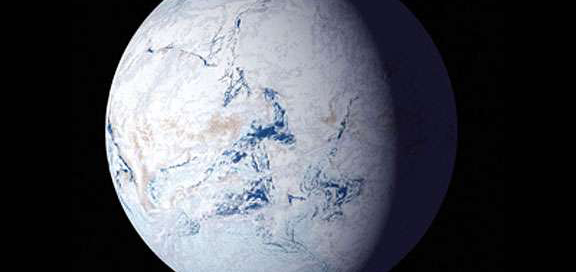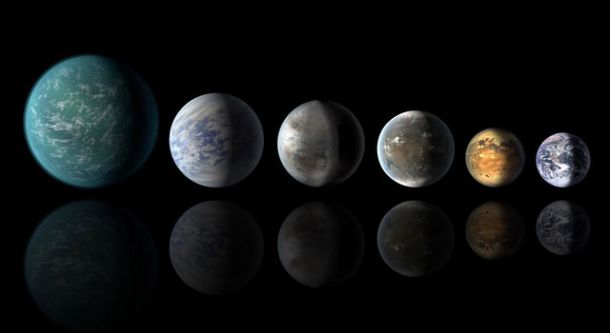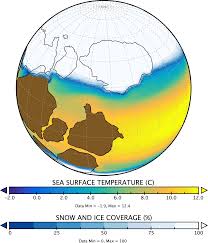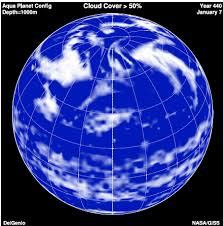
Some two billion years ago, all of Earth may well have been covered in snow and ice. Oceans, continents, everything, and for many millions of years. Observed from afar, the planet would be pretty low on the list of planets that might conceivably support life. But we know that it did.
Five hundred to seven hundred million years ago, our planet had what scientists have determined to be another severe period of cold, with the global mean temperature somewhere around 10 degrees F. Again, hardly a good candidate planet for life. But in fact, the tropics were ice-free and Earth’s biosphere was preparing for its biggest explosion of life ever.
These kinds of insights and conclusions are part of the work now underway to use the earth and its climate history as a way to understand exoplanets, and some day to predict the best targets for examination.

It is a field with numerous players, but perhaps none so deeply engaged as NASA’s Goddard Institute for Space Studies (GISS) in New York City.
Using the same 3D modeling that it produces to understand our currently changing climate, GISS and its collaborators is pushing further into the study of ancient Earth and solar system climates as a way to better understand exoplanets and someday identify potentially inhabited, or at least habitable, candidates.
Anthony Del Genio, a senior climate scientist at GISS, is the team leader for this novel effort, which includes some 30 scientists from a variety of institutions.

Undergirding the effort is the conviction that it would be a mistake to see exoplanets as static entities rather than as evolving bodies, with pasts and futures that can be as changeable as our own mutable planet.
“The beauty of Earth’s climate history for this project is that we have so many well studied fluctuations, and they give some tantalizing clues for a deeper understanding of other planets,” said Del Genio, whose team is sponsored by both the NASA Planetary Atmospheres, Exobiology, and Habitable Worlds Programs and the Nexus for Exoplanet System Science (NExSS,) a NASA initiative. Both stress an interdisciplinary approach to big issues, and this team is on the cutting edge of that approach.
As Del Genio explains: “Our planet started out uninhabitable and extremely hot. Over many millions of years it cooled down and in time life started. We know this happened when the atmosphere was still essentially without oxygen.
“Then both before and after the arrival of an oxygen atmosphere, the planet went into partial or potentially total snowball periods — millions of years when the Earth’s mean temperature was well below the freezing point.” The Cambrian explosion of multi-cellular life followed the global freezing, and that in turn led some millions of years later to the warm and lush Cretaceous and its dinosaurs.
Many of these dramatic shifts involve climate, planetary and solar system dynamics that until recently played a limited role in exoplanet research. But they do now. The GISS Global Climate Model (GCM) is already made up of hundreds of thousands of lines of computer code, and now it will be expanded substantially to allow for the 3D visualization of exoplanet climates and planetary dynamics as well. The potential power of the 3D exoplanet modeling is already apparent.
For instance, team member Linda Sohl used the GISS 3D model to see whether Earth circa 715 million years ago, with less carbon dioxide in the air, would be fully or partially covered in ice. This was a time when the sun was some 6 percent fainter, scientists have calculated. The model’s attention-grabbing conclusion: large swaths of ocean were ice-free, despite a global mean temperature of just 9.9 degrees Fahrenheit. So while global mean temperature is important, it does not alone determine the habitability of many planets. Factors like the makeup of an atmosphere, how heat is dispersed and the tilt of the planet also play defining roles.

For exoplanet research, her team concluded, this means that the habitable zone around stars may well be larger than generally described, taking in planets that might have been written off as too cold (or too hot) before. And since ice planets are of some considerable interest to astronomers because they shine so bright, this additional analysis (and others like it) could be quite useful in the years ahead.
“If we don’t know much about a planet, we don’t want to insert a lot of information into a model that we can’t validate. But on Earth we know that the paleobiology called for a slushball Earth around 700 million years ago rather than a hardball, a very cold place but with much open ocean. So the question is: What climate, what atmospheres, what physical dynamics make that possible on Earth and other planets?”
She said that so far, astronomical models of exoplanets have been pretty straight-forward, looking at distance from the sun, how much light is being reflected, the path of the planet’s orbit. But now the models can add atmospheres with differing chemical makeups, different spin axes for the planets, different planet sizes, different classes of suns and gravity conditions. The researchers can run the 3D models and then see what conditions are produced, and especially can see if they produce a possibly habitable climate and world.
It’s a bounty of added dimensions, and it brings often separated scientific disciplines together. And, says Sohl, it provides a constant reminder of the “enormous range of possibilities driving the conditions we actually see.”
The models can be used to create (or simulate) endlessly variable planetary conditions. What might happen, for instance, if an Earth-like planet rotated on its spin axis very slowly (a full rotation in 128 days rather than 24 hours?) The model shows a potentially more lush, “superhabitable” planet.
A computer generated “aridity index” that maps out the dry places (yellow-brown) and the wet places (green) of an Earth-like planet that rotates on its axis much more slowly than Earth. The slowly rotating version of Earth has climate zones very different from actual Earth – the Sahara desert has turned into a rain forest, and the northern U.S. and Canada have become more arid like Los Angeles. Overall, slowing the rotation produces a rocky planet with rain and possibly habitable conditions on more of the surface of the planet. (NASA GISS-Columbia University)
Or how about exploring a Venus from long ago that may have had oceans? It is generally believed that Venus and Earth formed with similar compositions, but that Venus’ closer position to the Sun created a “runaway greenhouse” effect that caused it to lose all its water and become the hot, dry place we see today. Lava from volcanic eruptions has covered most of the surface of Venus, and so the original features of “paleo-Venus” are in hiding.

But it does appear likely that Venus once did have a lot of water: the Pioneer probe to Venus more than 30 years ago found that the deuterium-to-hydrogen ratio on that planet is higher than on Earth. This means that there is a higher percentage of “heavy hydrogen” to regular hydrogen, and that is generally interpreted to mean there was once a lot of water.
So GISS climate modeler Michael Way took a topographic map of Venus based on findings from another mission, filled in the lowlands with an ocean of water, and ran the global climate model to simulate the climate of ancient days on Venus. The result was a planet with clouds that would block some of the sun’s rays and would produce a potentially habitable planet.
Del Genio and colleague Jeff Jonas also modeled a water-world exoplanet to see if it would be covered in clouds, as some had suggested. The water-world possibility has generally been associated with “super-Earths” with a lot more mass and atmospheric pressure than Earth, so the Earth-based model has its limits.
But Del Genio said it addresses at least one question that the exoplanet community has had about water worlds – whether the surface of an all-ocean planet would be impossible to see because of cloud cover. “Our simulation shows that is not the case – the aqua-planet has mid-latitude frontal storms just like we do in the U.S. and big convective storms in two bands on either side of the equator. But it has lots of clear areas as well. That’s because clouds form where air rises and dissipate where air sinks.”

The GISS exoplanet project in many ways looks forward to the time when NASA has a powerful exoplanet direct imaging telescope in the sky, perhaps in the 2030s, or when the next generation of vastly enlarged ground-based telescopes have been built and commissioned. Many researchers say that only with the ability to collect vastly more light than today from around the exoplanets will the most important details of their composition be revealed.
So a major part of the job of the exoplanet modeling team (and many other exoplanet scientists) is to prepare for that day.
“What we’re doing is trying to find the best places to point the telescopes, the most likely to support a habitable surface,” said Michael Way. “We’re helping to set the stage for discoveries coming 10, 20, 30 years from now.”


How to get the image of the other face of the temperature of oceanic Venus?
What is the real source of the image?
LikeLike